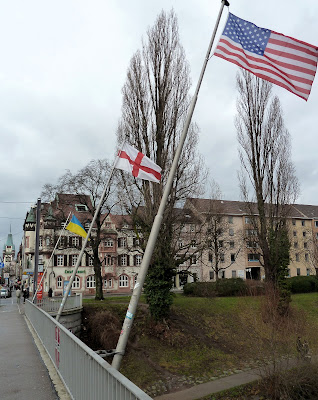The back story is that before the pope visited Freiburg, the city had considered the status of the flags flown on Kaiserbrücke, one of the main entries into town. The flags were all dirty, many of them torn. Looking into their provisions, the responsible persons located new national colors from Freiburg's partner cities and hoisted them.
Freiburg is the only city in Germany with a sister city in Iran. The partnership with Isfahan was criticized in the past. With political contacts not existing, the argument to keep it alive was always based on person-to-person communication.
The picture from Tuesday in the Badische Zeitung (BZ) shows the Iranian flag flanked by the English (Guildford) and the Ukrainian (Lviv) colors. Note that the Iranian flag is upside down. By the way, having the same patron saint, England's and Freiburg's flags are identical, showing St. George's Cross.
On the morning of Thursday, January 5, the Iranian flag disappeared. The flag pole had been dismounted and was located below the bridge in the Dreisam River. Frustrated that he had been deprived of a media-effective striking of the Iranian flag, the city councilor was unhappy and called the action carried out under cover of darkness vandalism.
 |
| Today on Sunday, January 8, I took a photo at a wider angle. In front are the Stars and Stripes (Madison). Between the English and the Ukrainian, the Iranian flag is missing. On the left-hand side in the back is the Martinstor. |
January 9: The Left Party (Die Linke) asked the city council to replace the Iranian flag as soon as possible, "As long as countries like the US and Germany carry war and death into the world, we should not dictate to the Iranians what to do."
January 12: Answering the request of Die Linke, the city administration said that they have no ersatz flag in stock. They will soon publish a statement concerning who in the Building and Gardening Department is responsible for choosing the countries and flags to be flown in public places.
January 14: Today, the BZ wrote: Neuer Dreh im Fahnen-Fall (New twist in the fall/case [it's a pun in German!] of the flag). The Association of the Friends of Tel Aviv (Israel) asked the mayor to replace the missing Iranian flag as soon as possible, claiming that the flag symbolizes the Iranian people and not the present administration. The CDU city councilor, a member of this association, did not understand his friends anymore and said, "The flag stands for the Mullah regime." The CDU spokesman for the city council group had initially endorsed the move but now somehow paddled backward, saying, "This issue needs to be discussed."
January 16: Today, the youth organization of Die Linke hoisted a homemade flag of the city of Isfahan as ersatz and in protest. For the left youth and the Association of the Friends of Tel Aviv, the stolen flag symbolizes the partnership with Isfahan.
 |
| An extremely poor ersatz flag |
January 18: The Christian Democrats are tired of the debate and propose to fly the flags of Freiburg's partner cities instead of the national flags. A city councilor of the Unabhängige Liste (Independent List) smirked: We note with pleasure that the CDU follows the proposal of Die Linke's youth organization. However, there are complications as the city administration had already discovered that our Partnerstadt Wiwili (Nicaragua) does not have a city flag.
January 24: The city council wanted to end the farce and decided to stick to the national flags since not all partner cities have a proper flag. The German expression Freiburg zeigt Flagge means that Freiburg will again show the Iranian colors to honor its unique partnership with Isfahan. To continue with the saga, a lady claimed from the off that the flag of Liberia must be shown, too, although the negotiations with its capital Monrovia for a partnership were put on ice in 1990.
January 27: While the Association of the Friends of Tel Aviv welcomes the city council's decision, the CDU is disappointed and commented: We must consider further steps.
February 1: As announced: An Iranian flag is back and no longer upside down.



